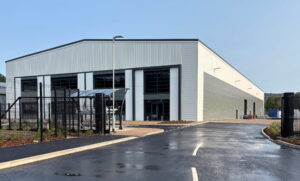UK’s Records cleanest recorded air quality at Bluestone’s Black Pool Mill
June 2025 marks nine months since Bluestone National Park Resort in Wales began monitoring the quality of its air, as part of the holiday resort’s commitment to sustainability and wellbeing, and data shows air at the historic Black Pool Mill on its estate is cleaner than any monitored by the UK government.
Air quality monitoring at Bluestone National Park Resort in Pembrokeshire, Wales, from September 2024 to June 2025 has revealed that the air at its historic Black Pool Mill site is cleaner than at all 195 locations monitored by the UK government’s DEFRA through the national AURN network.
Data collected and analysed by Professor Paul Lewis who is chief scientific officer at Health and Wellbeing 360 and Wales’ Clean Air Champion at the Clean Air Programme, compared concentration levels of PM2.5 across UK sites.
Data collection and analysis at Bluestone – the only family holiday resort situated within a coastal national park – has involved measuring and calculating the mean average of PM2.5, with continuous data sent for analysis on an hourly basis. PM2.5 is particulate matter with a diameter of 2.5 micrometres or less, that can be man made from the likes of aerosols and vehicle fumes or may naturally occur from the likes of dust and pollen.
Professor Paul Lewis, Chief Scientific Officer at Health and Wellbeing 360 and Clean Air Programme Regional Champion for Wales who leads on the collection and analysis of air quality data at Bluestone, said: “When it comes to levels of PM2.5, the maximum annual mean level permitted in Wales is 25 micrograms per cubic meter, whereas in England is set a bit lower at 20 micrograms per cubic meter. Black Pool Mill is clearly way below this with a mean average of just three micrograms per cubic meter. South Pembrokeshire is an area of clean air quality mainly due to its location on the west coast of the UK and westerly winds in the main. The wind blows in from the sea and isn’t picking up pollutants from human activities like other areas in the UK. Black Pool Mill showcases exceptionally clean air thanks to being away from industry, away from urban pollution, surrounded by ancient woodland, in a valley on an estuary on the banks of River Cleddau and is on Bluestone’s estate which is a car free resort.”
Environmental scientist, Marten Lewis, director of sustainability at Bluestone, said: “We’ve been monitoring the air quality at Bluestone National Park Resort since 2024 as part of our continuous efforts to reduce our impact on the environment, with the wellbeing of guests and staff front and centre, and are delighted but not surprised to learn that our Black Pool Mill has cleaner air than the cleanest air being monitored by the UK government. We have just won a King’s Award for Enterprise in sustainable development, and this new data is a wonderful addition to what makes us stand out not only as a regenerative tourism destination, but as a blueprint for best practice. Not resting on our laurels with this outstanding result for clean, healthy air, we’re working with Professor Paul Lewis looking to further improve air quality across the resort, including trialling a cleaning product with lower particulates. We’re hoping to monitor the indoor environmental quality within our lodges, pub and play areas too.”
Find out more about how people and the planet are at the heart of Bluestone National Park Resort and book a stay at bluestonewales.com
References
The findings, based on real-time measurements taken at Bluestone, benchmarked against DEFRA data, highlight Black Pool Mill as a standout location for clean, healthy air, reinforcing the resort’s commitment to sustainability and wellbeing.
17 of the background air quality monitoring sites in the UK show a mean average of 12 micrograms per cubic meter or less, with Black Pool Mill showing even lower levels at just 3 micrograms per cubic meter.
The Air Quality Standards Regulations (2010) require that concentrations of PM in the UK must not exceed. An annual average of 20 µg/m3 for PM2.5 in England. Article: https://www.gov.uk/government/statistics/air-quality-statistics/concentrations-of-particulate-matter-pm10-and-pm25
Table of mean PM2.5 data averaged between 01.09.2024 and 15.06.2025; Black Pool Mill monitor sends continuous PM2.5 concentration data.
Credit: Health and Wellbeing 360:
| Location
|
Mean PM 2.5 [micrograms per cubic meter; µg/m3] |
| Black Pool Mill | 3.0 |
| Auchencorth Moss (Midlothian) | 4.7 |
| Lough Navar (Fermanagh and Omagh) | 4.8 |
| High Muffles (Ryedale) | 6.2 |
| Yarner Wood (Teignbridge) | 6.4 |
| Ladybower (High Peak) | 7.0 |
| Narberth (Pembrokeshire) | 7.1 |
| Charlton Mackrell (S Somerset) | 8.3 |
| Lullington Heath (Wealden) | 8.5 |
| Glazebury (Salford) | 8.8 |
| Chilbolton Observatory (Test Valley) | 8.8 |
| Tallington (S Kesteven) | 8.8 |
| Toft Newton (W Lindsey) | 9.1 |
| Sibton (East Suffolk) | 9.2 |
| St Osyth (Tendring) | 9.8 |
| Weybourne (N Norfolk) | 9.8 |
| Wicken Fen (E Cambridgeshire) | 10.2 |
| Rochester Stoke (Medway) | 11.3 |
Data acquired from Defra’s Automatic Urban and Rural Network (AURN) publicly available resource:
https://uk-air.defra.gov.uk/networks/network-info?view=aurn
About Professor Paul Lewis
Professor Paul Lewis is a genetic toxicologist who specialises in assessing the impacts of air pollution on health. After a long career in academic research at Cardiff University and Swansea University, he is now Chief Scientific Officer at Health and Wellbeing 360, part of the Raven Delta Group. A major part of his research now is focused on the impacts of indoor environmental factors on health and developing technologies and data standards to improve measurements. He is a Professor Emeritus at Swansea’s Medical School and the UKRI Clean Air Programme Regional Champion for Wales, helping support efforts to raise awareness of poor air quality by engaging with academia, industry, local government, healthcare, the educational sector and third sector organisations. In 2024 he was appointed as Chair of the Welsh Government Clean Air Advisory Panel leading the expert group advising Ministers on new policy around air quality. In 2020, he led the Panel’s report into the ‘Impacts of the Covid-19 pandemic on air quality in Wales’. He is also Chair of the Welsh Government Promoting Awareness of Air Policy Working Group helping Ministers develop a forthcoming delivery plan for Wales. He has presented the links between air quality and health on behalf of the Welsh Government at public consultation events in preparation for the Environment (Air Quality and Soundscapes) (Wales) Act 2024. He has also been a member of the Welsh Government Air Quality Direction Independent Review Panel since 2018 and sits on the Welsh Parliament Cross Party Group – A Clean Air Act for Wales.
About Bluestone National Park Resort
Bluestone National Park Resort is a 5* luxury, self-catering holiday resort near Narberth, Pembrokeshire, nestled in 500 acres of rolling countryside. The resort has over 400 accommodation units and offers a diverse array of activities as well as the opportunity to explore the Pembrokeshire coastal national park. Bluestone has been voted the no.3 holiday park and resort in the UK and ‘Wales top resort’ in 2024 Which? Survey, over and above Center Parcs, Warner Leisure Villages and Parkdean. The resort has been committed to improving sustainability and maintaining the local environment since opening in 2008. Bluestone’s Carbon Footprint is calculated externally by the Zero Carbon Forum, with scope one and two energy emissions publicly disclosed annually through Companies House. Bluestone is accredited by CSR-A, with a range of ESG initiatives which support social, economic and ecological resilience. The resort, located within Pembrokeshire Coast National Park, recognises the opportunity for biodiverse ecosystems to be created in otherwise barren land across the UK and beyond through the sharing of its operational blueprint. Having regenerated dairy farmland which was once an ecological desert into a tapestry of thriving nature reserve environments, its proven model is unique to other village holiday resorts which, conversely, build upon existing areas of beauty and then seek to sustain them.
About Black Pool Mill
When Bluestone National Park Resort was founded in 2008, Black Pool Mill, which is part of Bluestone’s estate, had already closed to the public and soon passed entirely into Bluestone management. With a full appreciation for the mill’s rich history and heritage, Bluestone has since worked tirelessly to safeguard this historically significant building and landscape for future generations. In 2020 planning permission was granted to transform the mill into a heritage restaurant, open to both staying guests and the public all year round, necessitating a sympathetic and careful programme of works ranging from preservation to restoration and then transformation. The early preservation phase included replacing the roof and the roof timbers of the main mill building, the two annexes and the neighbouring outbuilding, and the fabrication of 53 handmade wooden sash windows. This has ensured the mill remains watertight for all seasons. https://www.bluestonewales.com/about-us/projects/blackpool-mill
About Health and Wellbeing 360
Health and Wellbeing 360 has a mission to innovate, educate, and collaborate to enhance the health and wellbeing of individuals, communities, and populations. Working across industry, academia, the public sector, and governments, Health and Wellbeing 360 are dedicated to advancing wellbeing for future generations through innovation in indoor and outdoor environmental quality. They specialise in leveraging data science and R&D to improve Indoor and Outdoor Environmental Quality (IEQ and OEQ) and health. Another unique strength lies in their ability to generate and utilise high-quality data that informs the development of standards and strategies. They focus on transforming built and outdoor environments into healthier spaces. This approach creates a robust platform for sustainable health and wellbeing, emphasising their role as data specialists and leaders in IEQ and automating critical reporting such as ESG and occupational health and wellbeing at the level of governments, organisations, communities and people.
Image Credit: Bluestone National Park Resort.





